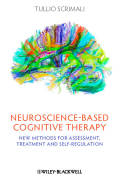
Neuroscience-based cognitive therapy: new methods for assessment, treatment and self-regulation
Scrimali, Tullio
A pioneer of CBT explores recent advances in neuroscience, showing how they can be applied in practice to improve the effectiveness of cognitive therapy for clients with a wide range of diagnoses including mood disorders, anxiety disorders, eating disorders and schizophreniaUtilizes the latest advances in neuroscience to introduce tools that allow clinicians, for the first time, to directly ‘measure' the effectiveness of cognitive therapy interventions Rigorously based in neuroscientific research, yet designed to be readable and jargon-free for a professional market of CBT practitioners Covers theory, assessment, and the treatment of a wide range of specific disorders including anxiety disorders, mood disorders, eating disorders, addictions and schizophreniaWritten by a respected pioneer in the field INDICE: Foreword by Arthur Freeman xiiiPreface xixAcknowledgments xxiList of Abbreviations xxiiiIntroduction 1Part I Neuroscience in Context1 Neuroscience, Clinical Psychology, and Cognitive Therapy 52 The Mind–Brain Problem113 Motor Theories of Mind and a Complex Biocybernetic Model in Neuroscience 204 Complexity, Chaos, and Dynamical Systems 274.1 Introduction 274.2 Complexity 274.3 Chaos Theory 294.4 Complex Systems 304.5 From Complexity to a Neuroscience-based Cognitive Therapy 325 Modular and Gradiental Brain, Coalitional Mind 355.1 Introduction 355.2 The Modular and Gradiental Brain 375.3 The Social Brain 415.4 The Central Nervous System, Neurovegetative Nervous System, and Visceral Brain 445.4.1 The Neurovegetative Nervous System 445.4.2 The Visceral Brain 465.5 Paleognosis and Neognosis in theMind of Homo sapiens 475.6 Memory 485.7 Internal Representational Systems 515.7.1 Imagery 525.7.2 Internal Dialog545.8 Knowledge Processes 545.8.1 Introduction 545.8.2 The Unconscious and Tacit Dimension 555.8.3 Information Coding in the Human Brain 575.8.4 Tacit Knowledge: Experiencing 595.8.5 Explicit Knowledge: Explaining 595.8.6 Procedural Knowledge: Acting 605.8.7 Social or Machiavellian Intelligence: Relating 615.9Coalitional Processes 625.9.1 The Self 625.9.2 Personal Identity 665.9.3 Narrative 676 Phylogenesis of the Brain and Ontogenesis of the Mind: Biological and Cultural Evolutionism 706.1 The Reptilian Brain: The Archipallium 766.2 The Limbic System: The Paleopallium 766.3 Brain Structures of Less Evolved Mammals: The Neopallium 776.4 Specialized Frontal Lobes 77Part II Clinical Psychophysiology and its Parameters7 Psychophysiology and Clinical Psychophysiology 838 Electroencephalography and Quantitative Electroencephalography 868.1 Electroencephalography 868.1.1 Frequency 878.1.2 Amplitude 888.1.3 Morphology 898.1.4 Symmetry 898.1.5 Coherence 898.1.6 Artifacts 908.2 Quantitative Electroencephalography 918.2.1 Technical and Methodological Aspects 929 Electrodermal Activity and Quantitative Electrodermal Activity 969.1 Electrodermal Activity and itsRecording 969.2 Computer-Aided Analysis of Electrodermal Activity and Quantitative Electrodermal Activity 1039.3 Reference Database 1079.4 Evoked Electrodermal Responses 1119.5 Effects of Psychoactive Drugs on Electrodermal Activity 1119.5.1 Beta-Blockers 1129.5.2 Benzodiazepines 1139.5.3 Neuroleptics 1149.5.4Antidepressants 1159.5.5 Anti-Epileptic Drugs, or “Mood Stabilizers” 11510 Complex Psychological Diagnosis and Instrumental Psychodiagnostics 11610.1 Introduction 11610.2 Functional Diagnosis 11810.3 Instrumental Psychodiagnostics 12010.4 The Contribution of Neuroscience to a Complex Diagnosis 120Part III Neuroscience-basedMethods in the Clinical Setting11 Complex Psychological Diagnosis with Quantitative Electroencephalography 12511.1 Introduction 12511.2 Dementia 12611.2.1 Materials 12611.2.2 Method 12711.2.3 Results 12811.3 Schizophrenia 12911.4 Depression 13211.5 Mania 13311.6 Attention Deficit Hyperactivity Disorder 13311.7 Obsessive-Compulsive Disorder 13312 Complex Psychological Diagnosis with Quantitative Electrodermal Activity 13512.1 General Aspects 13512.1.1 Setting 13512.1.2 Advising the Patient 13612.1.3 Testing 13612.1.4 Assessing and Reviewing Results with the Patient 13712.1.5 Planning Treatment 13712.1.6 Use of Recorded Data for Constructing a Narrative on the Self-Regulation Process 13912.2 Data Regarding Specific Clinical Disorders 13912.2.1 Generalized Anxiety Disorder 13912.2.2 Panic Attack Disorder 14012.2.3 Post-Traumatic Stress Disorder 14012.2.4 Phobias 14012.2.5 Obsessive-Compulsive Disorder 14012.2.6 Depression 14012.2.7 Eating Disorders 14112.2.8 Addictions 14112.2.9 Schizophrenia 14112.2.10 Mania 14112.2.11 Attention Deficit Hyperactivity Disorder 14112.2.12 Stuttering 14212.2.13 Hypertension 14212.2.14 Irritable Bowel Syndrome 14312.2.15 Premenstrual Syndrome 14312.2.16 Psychogenic Impotence 14313 Sets and Settings when Applying a Neuroscience-based Clinical Methodology 14514 Multimodal Assessment of Family Process and the “Family Strange Situation” 15214.1 The Family Strange Situation Procedure 15415 Biofeedback, Neurofeedback, and Psychofeedback 15615.1 Theoretical Foundation and Historical Development 15615.2 Physiological and Psychophysiological Biofeedback 16315.3 Biofeedback and Cognitive Therapy 16515.4 MindLAB Set-based Coping Skills Training 16815.5 Relaxation, Self-Control, Self-Regulation 16816 Meditation, Mindfulness, and Biofeedback-based Mindfulness (BBM) 17116.1 Meditation 17116.1.1 Types of Meditation 17116.2 Mindfulness 17516.3 Biofeedback-Based Mindfulness 17717 Neurofeedback and Cognitive Therapy 18017.1 Insomnia 18017.2 Obsessive-Compulsive Disorder 18317.3 Attention Deficit Hyperactivity Disorder 18617.4 Depression 18717.5 Mania 18717.6 Drug Dependency 18718 Psychofeedback and Cognitive Therapy 18918.1 Mental Disorders 19018.1.1 Panic Attack Disorder with or without Agoraphobia: Dedalo Protocol 19018.1.2 Obsessive-Compulsive Disorder: Sisifo Protocol 19018.1.3 Mood Disorders: Galatea and Eolo Protocols 19118.1.4 Substance Addiction-Related Disorders: Baccheia Protocols 19118.1.5 Eating Disorders: Fineo and Tantalo Protocols 19118.1.6 Personality Disorders: Polifemo Protocol 19118.1.7 Schizophrenia: Negative Entropy Protocol 19118.1.8 Attention Deficit Hyperactivity Disorder 19218.1.9 Stuttering 19218.2 Psychosomatic Disorders 19218.3 Meditation, Mindfulness, Music Therapy 19319 Monitoring theWarning Signs of Relapse in Schizophrenia and Bipolar Disorder, and Coping with Them 19419.1 Introduction 19419.2 Schizophrenia 19419.3 Bipolar Disorder 19619.4 Coping with Prodromal Symptoms of Relapse in Psychosis 19620 Get Started with Neuroscience-based Cognitive Therapy 197References 199Index 217
- ISBN: 978-1-119-99375-9
- Editorial: John Wiley & Sons
- Encuadernacion: Cartoné
- Páginas: 256
- Fecha Publicación: 04/05/2012
- Nº Volúmenes: 1
- Idioma: Inglés
